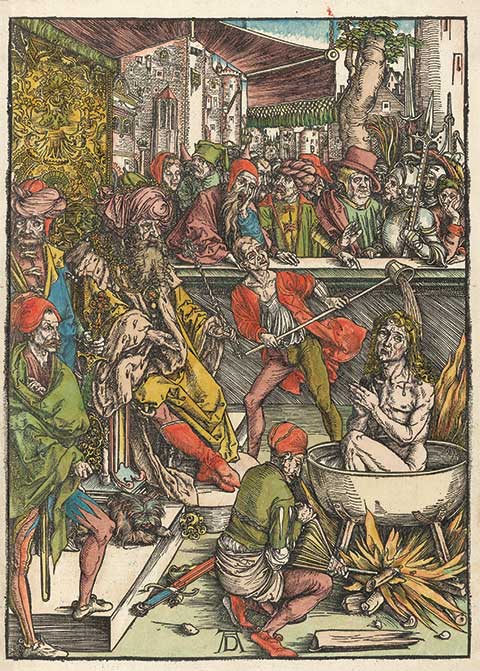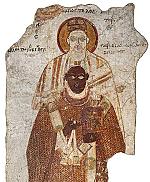John's Golden Legend

[ABOVE: Albrecht Dürer, The Martyrdom of Saint John the Evangelist. 15th or 16th Century. Laid paper and woodcut print. Nuremberg—Houghton Library / Public doman, Wikimedia]
The Golden Legend (c. 1260) by Jacobus de Voragine is a large collection of hagiographies popular in the late Middle Ages. The excerpt below expands on legends about John, some of which date back to Tertullian, who wrote in Against Heretics, “How happy is [Rome’s] church, on which apostles poured forth all their doctrine along with their blood! . . . Where the apostle John was first plunged, unhurt, into boiling oil, and from there sent to his island exile!”
UNBOILED AND UNDETERRED
At this time, the Roman Emperor Domitian, who was persecuting Christians, had the Apostle John arrested and brought to Rome. There he had John cast into a vat of hot oil. By God’s help, John came out of the vat without suffering from the heat.
Afterward, the emperor saw that John did not cease to preach Christ, so he sent him into exile on the Island of Patmos. There by revelation of our Lord, John wrote the Apocalypse, which contained the secrets of the holy church and of the world to come. . . .
DESTROYING DIANA’S TEMPLE
After this, when the blessed Apostle John had preached through all Asia Minor, the idol worshipers stirred up the people against him and drove him into the Temple of Diana to force him to sacrifice to that idol. John said, “If you believe that your goddess Diana has such great power, call upon her to overthrow the church of Christ, and if she does so, I will sacrifice to her. But if she does not, then let me pray to my God Jesus Christ that he overthrow her temple, and if he does so, you believe in him.”
Most people consented to this idea, and they prayed. But they could not prevail against the church of Christ. But when John prayed, the Temple of Diana was overthrown. The foundation was turned upside down and the statue of Diana was destroyed. That same day, 12,000 Gentile men plus women and children were converted to faith in Christ.
Then Aristodemus, bishop of the idols, stirred up sedition among the people. Then the apostle said to him, “What must I do to appease you?” The bishop replied, “If you want me to believe in your God, I will give you poison to drink, and if it does not hurt you, then your Lord is truly God.” John answered, “Do as you have said.”
And the bishop said, “First, I want you to see others die from the poison so that you may fear it all the more.” Then Aristodemus went to the proconsul of the city and demanded two men sentenced to execution, and before everyone, he gave them poison to drink. Immediately, these men fell down dead. Then John took the cup of poison and drank every drop of it, and he felt no harm. Therefore, all the people gave praise to God. Aristodemus then said, “I still have a doubt, but if you are able to raise these dead men to life again, then I will believe.”
Then the apostle said, “Go and lay my coat over the bodies of the dead men, saying ‘The apostle of Christ sent me to you so that you will arise in the name of Christ’.” When the bishop did this, the two men rose from death to life. Then the bishop and the proconsul believed, and John baptized them, with all their family and friends. Afterward, they broke their idols and in honor of John, they built a church to worship God.
By Jacobus de Voragine
[Christian History originally published this article in Christian History Issue #156 in 2025]
The Golden Legend, or Lives of the Saints by Jacobus de Voragine, translated by William Caxton and adapted by Rex D. ButlerNext articles
Support us
Christian History Institute (CHI) is a non-profit Pennsylvania corporation founded in 1982. Your donations support the continuation of this ministry
Donate







